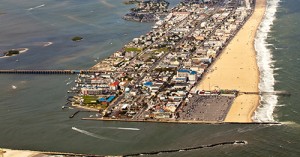
OCEAN CITY — The federal Army Corps of Engineers (ACE) on Monday announced it has recognized the urgent need for a long-term solution to the chronic shoaling of the Inlet and has agreed to embark on an ambitious dredging plan.
Delegate Mary Beth Carozza (R-38C), who represents Ocean City and Worcester County, announced on Monday the Army Corps of Engineers has responded to the community’s request that actions be taken to address the increased shoaling in the Inlet and the navigation channels around the commercial harbor. In a letter to Carozza, Army Corps Baltimore District Commander Colonel Edward Chamberlayne recognized and agreed with the urgent need to resolve the continual shoaling situation in the Ocean City Inlet and the increase rates of erosion and shoaling in the federal navigation channels in the area.
Citing the increased need for frequent short-term dredging in the Inlet and surrounding areas in recent years, the Corps further agreed that a more comprehensive, long-term solution is needed and recommitted to dredging the channels as necessary for safe navigation as federal funding allows. This spring, it came to light the continued shoaling of the Inlet was negatively affecting commercial and recreational fishing and boating activities out of Maryland’s only Atlantic port to the point some commercial fishermen have moved their operations out the commercial harbor in West Ocean City.
The Inlet continually fills in through natural and man-made processes and is often impassable for larger drawing vessels, particularly during low tide. While the Inlet and other channels in and around the mouth of the commercial harbor naturally fill in and are in need of continual maintenance dredging, the problem has become more acute in recent years to the point it is now curtailing commercial and recreational activity out of Ocean City.
In April, over 40 representatives from the federal, state and local government along with a strong contingent of commercial and recreational fishermen and members of the business and environmental communities met to discuss the problem of the Inlet depth, which is often as low as 10 feet.
Based on those discussions, the Town of Ocean City, Worcester County and the state’s Department of Natural Resources (DNR) sent a letter to the ACE requesting federal assistance with the dredging of the Inlet and harbor to a deeper standard of 14-16 feet. In June, the ACE responded by taking short-term action and conducted regular maintenance dredging of the channels throughout the summer. On Monday, through a letter to Carozza, the ACE agreed to embark on a long-term solution paid for with federal dollars.
To that end, the ACE is undertaking a series of actions to achieve a successful resolution to the chronic shoaling problem in the Inlet and surrounding channels. The first step is a Federal Interest Determination report, which is due by the end of this year. The report, if approved, will allow the ACE to study and model the hydrodynamics of the Inlet and harbor area to determine potential long-term solutions to the shoaling problem at 100-percent federal cost.
According to the ACE letter to Carozza, following the hydrodynamics study, the Corps would then take up an effort to permanently increase the depth of the harbor to 14 feet and the Inlet to 16 feet as requested on behalf of the commercial and recreational fishermen.
“The Army Corps of Engineers recognizes and agrees with us that we have an urgent need to resolve the continual shoaling in the Ocean City Inlet,” Carozza said on Monday. “We need to keep the momentum going, showing the unity of the local, county and state partners, so we can resolve both the short-term and long-term shoaling problems in the Inlet and surround bay waters.”
Back in 1998, the Army Corps of Engineers completed its Ocean City, Maryland and Vicinity Water Resources Study, which correctly predicted many of the shoaling problems taking place now, but apparently the problems have developed more rapidly than predicted. At that time, the study recommended the Inlet and harbor depth be increased to 14 feet and 16 feet respectively. However, those plans were scrapped due to funding issues when the economy bottomed out.
The resulting negative economic impact to the city, county and state is millions of dollars in lost revenue, according to local officials. Some of the commercial vessels working out of the West Ocean City harbor have left the area and others are threatening to do so because of constant problems upon returning to the dock to unload their catches and damages to their fleets from bottoming out.
